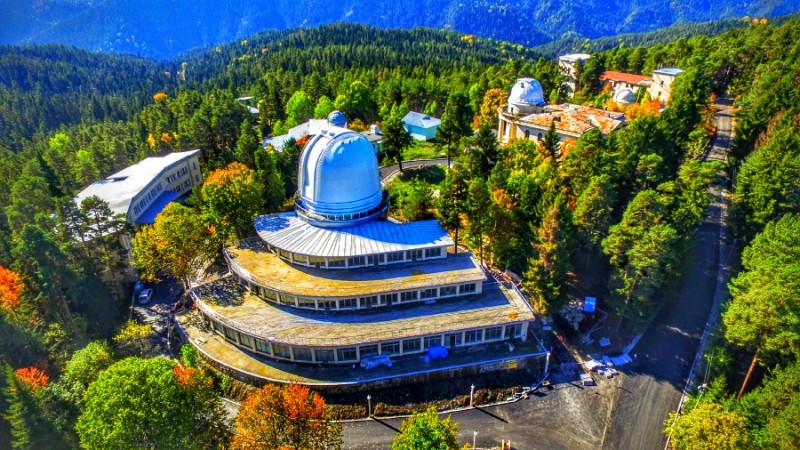Abastumani Astrophysical Observatory

Abastumani Astrophysical Observatory, a scientific-research institution of the Georgian Academy of Sciences, was the first high-altitude astrophysical observatory in the former Soviet Union.
It was founded in 1932 in Abastumani (E. Kharadze was the founder and permanent head until 1993, J. Lominadze was the director after 1993). In 1937, it was moved to the Mt. Kanobili (1650 m above sea level) near Abastumani. The atmosphere here is characterized by high transparency and stability. The average annual number of sunny days is approximately 250. The main domains of the scientific-research work of the Abastumani Astrophysical Observatory are: the study of the galaxy through the photometric, spectral, photographic astrometry and star dynamics methods; the study of non-stationary and variable stars through electrocolorimetric and spectrophotometric methods; observations of the photosphere, chromosphere and corona and the study of physical processes taking place in its active formations, etc. The basic equipment of the Abastumani Astrophysical Observatory includes: a fully automated reflecting telescope with a diameter of 1.25 m, meniscus telescope with a diameter of 70 cm, reflector with electro-photometer with a diameter of 48 cm, double astrograph with a diameter of 40 cm, Coma-free Schmidt telescope with a diameter 36–44 cm. The methodology of photoelectric and colorimetric observations has been developed and implemented in the observatory; extensive catalogs of spectral and color indicators of stars have been published; many regularities of the distribution of matter and its properties in the interstellar space have been established; the method of calculating the spatial densities of stars has been developed; the polarization of the Crab Nebula has been discovered and its connection with radio radiation has been indicated; 2 comets, up to 10 small dwarfs, up to 10 variable stars, 4 new stars, 5 supernovae, several hundreds of emission-line, peculiar and flare stars, several planetary nebulae and star clusters have been discovered. The Abastumani Astrophysical Observatory has been effectively participating in the international “Sun Service” since 1937.

In 1967, Abastumani Astrophysical Observatory laboratory was established in Tbilisi. Abastumani Astrophysical Observatory has been publishing a “bulletin” since 1937, in which the results of observations and research conducted in the observatory are published; has been publishing the Astronomical Calendar (since 1961) with the Astronomy Department of Tbilisi State University.
Literature: Харадзе Е. К., Абастуманская астрофизическая обсерватория, [М.], 1958; and his: Абастуманская астрофизическая обсерватория на горе Канобили, კრ.: Академия наук Грузинской ССР, Тб., 1981.


